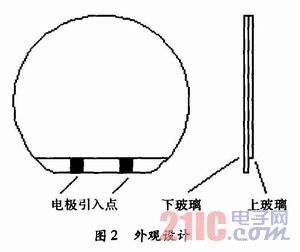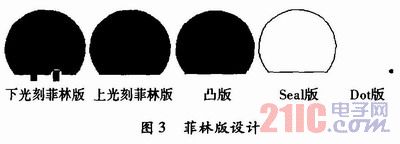The door mirror is commonly known as the cat's eye. Looking out from the room through the door mirror, you can see that the field of view is about 120. All the scenes in the range, but from the outside of the door with the naked eye through the door mirror can not see anything in the room. However, the lawless elements can easily see the condition of the room from outside the door through an optical instrument consisting of optical lenses.
In this paper, the infrared detection technology and the optical switch characteristics of the liquid crystal cell are used to provide a new method for solving the anti-peeping door mirror, which provides a new solution for the anti-spy technology of the door mirror and has broad market prospects.
1 Structure Introduction Anti-theft door mirror consists of optical system, liquid crystal cell and its control circuit, infrared detection and its control circuit.
1.1 Optical part The ordinary door mirror consists of 4 lenses. From the outside to the inside, there are 3 concave lenses that are close together and a convex lens that is far apart. Three close concave lenses can be equivalent to a short focal length. A set of concave lenses, called an objective lens. The convex lens is another set, called the eyepiece, as shown in Figure 1.
This article refers to the address: http://

1.2 The liquid crystal cell part of the liquid crystal cell is between the objective lens and the eyepiece, and two electrodes are taken out. When there is no voltage on the electrode, the liquid crystal cell is "opened", and the light can pass freely through the liquid crystal cell, which has no effect on the optical path of the door mirror. When a certain amplitude of AC voltage is applied to the electrode, the light cannot pass through the liquid crystal cell. At this time, the liquid crystal cell is "closed", and the optical path of the door mirror is blocked, thereby preventing the peek.
The alternating current applied to the electrodes is supplied by an oscillator. The effective value of the voltage is 2 to 3 V and the frequency is tens to hundreds of Hz.
1.3 Infrared detection part The infrared detector is a reflective optocoupler consisting of a pair of infrared emission receiving tubes mounted on one side of the eyepiece. The launch tube emits infrared light. When no one is in the room, the receiving tube can not receive the reflection signal of the human body; when someone in the room looks out from the side of the eyepiece, the receiving tube receives the reflected signal of the human body, and generates a response signal after being processed by the amplifier and the relay.
2 LCD box design
2.1 Design Because the door mirror is circular, the basic structure of the liquid crystal cell is circular, and its diameter is the same as the inner diameter of the door mirror. Since the liquid crystal cell requires two control electrode introductions, a notch is left under the circle to connect the pins, as shown in FIG.

2.2 Film design In the manufacturing process of the liquid crystal cell, the required electrode pattern needs to be formed on the conductive layer of the conductive glass. This process is currently performed by photolithography, and the lithography needs to be specific. The film version of the film, which is made by film making a black and white pattern corresponding to the electrode pattern on the film, the black area can block the light, and the transparent area allows the light to pass.
Several important processes in the production process of liquid crystal cells are lithography, PI coating, rubbing, silk screen printing and other processes. The photolithography process is to engrave the electrode pattern on the glass. The film version used for the exposure needs to be designed. Because the liquid crystal cell is composed of two upper and lower pieces of glass, there are two upper and lower lithography film plates; the PI coating is made with a relief plate. The letterpress needs a film version; the silk screen printing process requires screen printing, and the screen printing used for screen printing requires two film versions, one is the Seal version of the printed frame, and the other is printed with conductive dots. Dot version; therefore, a total of 5 film versions need to be designed. The five film versions of the LCD box required for the security door mirror are shown in Figure 3.

3 circuit design shown in Figure 4, NAND gate U2, capacitor C6 and resistors R5, R6 constitute a multivibrator. When the voltage is applied to the 14th leg of the NAND gate U2, the oscillator starts to work, and the square wave is output to the liquid crystal cell, so that the liquid crystal cell is in the "on" state. Otherwise it will "close" the cell.

LED and D1 form a reflective optocoupler (ie, infrared detector). When no one is close to the probe, the infrared emitted by the LED cannot be reflected to D1, the photosensitive tube D1 is in the blocking state, and the transistor Q1 is in the absence of the base bias. In the off state, the power supply voltage is applied to the base of the transistor Q2 via D2 and R3, so that it is turned on, so that the relays 1 and 8 have current passing through them, and the 2 pins are connected to the 4 pins and disconnected from the 3 pins, and the oscillation circuit is lacking. When the power is turned off, the liquid crystal cell is "closed", and the outdoor person cannot observe the room through the optical instrument. Conversely, when someone in the room approaches the probe, the 2 and 4 pins of the relay are disconnected from the 3rd pin, and the oscillator begins to oscillate, thereby causing the liquid crystal cell to "open" and the outside person can observe the outside situation.
4 Conclusion The anti-theft door mirror was observed after assembly and circuit debugging. When viewed from the side of the objective lens, it is dark, which is because the liquid crystal cell is in a light blocking state. When viewed from the side of the eyepiece, the infrared detector works immediately, making the cell "open", allowing you to freely observe the condition on the side of the objective. Therefore, the anti-theft door mirror meets the requirements for use from design, processing to assembly.
Solar energy powered,green lighting, no electric bill;Wider application, can be installed in any place with sufficient sunlight;No need for traditional electricity and little maintenance;No wire laying, easy installation and little maintenance required;Maintenance free battery, service life as long as 5 years;More detals about 9w Integrated Solar Street Light;Integration of solar garden light (9w) models;Solar panels are the most powerful 18v 25w (high-efficiency mono crystalline silicon);Battery type lithium battery;LED lamp (with body sensors) maximum power: 9w 12 v;High brightness LED chip brand American pury :Lumen (LM) 3000-3300 L
30W Integrated Solar Street Lights
30W Integrated Solar Street Lights,Integrated Solar Street Light 30W,Integrated 30W Solar Street Light,Integrated Solar 30W Led Street Light
Yangzhou Bright Solar Solutions Co., Ltd. , http://www.cnbrightsolar.com